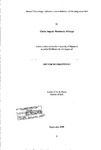Art and Technology: coherence, connectedness, and the integrative field
| dc.contributor.author | da Nobrega, Carlos Augusto Moreira | |
| dc.contributor.other | Faculty of Arts, Humanities and Business | en_US |
| dc.date.accessioned | 2013-10-21T10:40:10Z | |
| dc.date.available | 2013-10-21T10:40:10Z | |
| dc.date.issued | 2009 | |
| dc.identifier | NOT AVAILABLE | en_US |
| dc.identifier.uri | http://hdl.handle.net/10026.1/2248 | |
| dc.description | Merged with duplicate record 10026.1/690 on 03.04.2017 by CS (TIS) | |
| dc.description.abstract |
This thesis is a theoretical and practical intervention in the field of art and technology. It proceeds from the re-examination of four specific domains that in the past 40 years have considerably informed the invention of new aesthetic forms. They are: art, science, nature and technology. We have identified that each one of these domains and the way they inform one another reflects the influence of a Western analytical tradition based on fragmentation, dichotomies and dualities. In consequence of this, art of the last decades has suffered from a sort of mechanistic thought which results from a predominantly weary aesthetic model, founded in dualities such as: object/process, form/behaviour, meaning/information. The main question that the present study addresses is how to overcome this predominantly reductionist inheritance and to develop an aesthetic model able to interconnect in an integrative fashion those disparate domains, respective discourses and practices? The answer to this question, developed throughout this thesis, is an aesthetic principle built upon the notions of resonance, coherence and field models, rooted in an integrative view of living organisms based on the theory of biophotons. This constitutes the main contribution of the thesis to new knowledge. The theoretical approach of this thesis is developed upon the revision of the concept of form, supported by a Gestalt analysis as provided by Rudolf Arnheim, and has involved the consideration of the ideas of Gilbert Simondon (the concept of "concretisation") and Vilem Flusser (the concept of "apparatus"), in order to gain a deeper insight into the nature of technology. In conclusion, the practice-based methodology of this thesis has been to develop artworks based on the confluence of living organisms (plants) and artificial systems in order to permit empirical observation and reflection on the proposed theory. The major outcome of the practice is the artwork "Breathing", a hybrid creature made of a living organism (a plant) and an artificial system. The creature responds to its environment through movement, light and the noise of its mechanical parts and interacts with the observer through his/her act of breathing. This work is the result of an investigation into plants as sensitive agents for the creation of art. The intention was to explore new forms of artistic experience through the dialogue of natural and artificial processes. | en_US |
| dc.language.iso | en | en_US |
| dc.publisher | University of Plymouth | en_US |
| dc.title | Art and Technology: coherence, connectedness, and the integrative field | en_US |
| dc.type | Thesis | |
| dc.identifier.doi | http://dx.doi.org/10.24382/3780 |
Files in this item
This item appears in the following Collection(s)
-
01 Research Theses Main Collection
Research Theses Main


